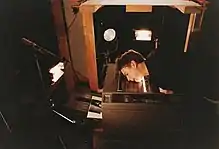Choreography for Copy Machine
Choreography for Copy Machine (a.k.a. Photocopy Cha Cha) is a four-minute animated film by independent filmmaker by Chel White.[1][2] All of the film's images were created solely by using the unique photographic capabilities of a photocopier to generate sequential pictures of hands, faces, and other body parts. Widely considered the first noteworthy animated film using this technique,[3] the film achieves a dream-like aesthetic with elements of the sensual and the absurd.[4] The Berlin International Film Festival describes it as “a swinging essay about physiognomy in the age of photo-mechanical reproduction.[5] Filmfest DC calls it, "true art in the age of mechanical reproduction; a rhythmic celebration of a photocopier’s cinematic potential." The Dallas Observer says, "(The film) takes a game we've all played with our hands, faces, and other body parts and raises it to the sublime." The Austin Chronicle writes, "(the film) pulses with a grinding sort of ghostly sexuality.”[6] Alive TV says, "Your relationship to your copy machine may never be the same.” And The Washington Post describes the film as “(a) musical frolic which wittily builds on ghostly, distorted images crossing the plate glass of a copier.”[7]
%22.jpg.webp)

Awards/Film Festivals
- Best Animated Short Film - 1992 Ann Arbor Film Festival
- Gold Plaque - 1992 Chicago International Film Festival[8]
- First Place - 1992 USA Film Festival
- Official Selection - 1991 Rotterdam International Film Festival[9]
- Official Selection - 1992 Berlin International Film Festival[10]
- Special Program - 2001 Sundance Film Festival[11]
References
- https://www.awn.com/animationworld/what-are-all-those-paint-men-digging-choreography-copy-machine-photocopy-cha-cha
- https://www.ilianfilm.com/cinema-history.html
- http://www.atlasobscura.com/articles/how-xerox-invented-the-copier-and-artists-pushed-it-too-its-limits
- http://www.chelwhite.com/photocopy-cha-cha/
- https://www.berlinale.de/en/archiv/jahresarchive/1992/02_programm_1992/02_Filmdatenblatt_1992_19923179.php
- http://www.austinchronicle.com/screens/2003-08-08/171978/
- https://www.washingtonpost.com/archive/lifestyle/1991/08/30/movies/3910b217-e835-4373-8820-63aa76040e0c/
- http://www.chelwhite.com/pressbio
- https://www.iffr.com/en/films/photocopy-cha-cha/%5B%5D
- https://www.berlinale.de/de/archiv/jahresarchive/1992/02_programm_1992/02_Filmdatenblatt_1992_19923179.php
- http://history.sundance.org/films/2320/choreography_for_a_copy_machine_photocopy_cha_cha